This has taken a little longer than anticipated. The twists and turns are all below. Part brioche, part focaccia … this is Bro-caccia. Thanks for joining me, folks.
20 years ago I had a moment with a focaccia.
It went like a Missed Connections: I was on the A train platform. You asked if you could transfer to the express. I said, “Depends on where you want to go.” “Uptown,” you responded with a smile that suggested we spend our lives together? … I lost you in the crowd.
The missed connection focaccia was a thin slab of enriched dough topped with dried fruit, sliced almonds, and coarse sugar; an invention of the brilliant Paula Oland at Balthazar Bakery in New York City. I had never had anything like it — unexpected, and barely sweet. It pried my eyes open to the possibilities of what I had always considered savory territory. It’s lived in my memory for 20 years.
So I decided to figure it out. But chasing what the mind recalls is probably fool’s territory. In the weeks since I started trying to resurrect what I remember, the recipe has had more twists than a pig’s tail.
While I’ve been frustrated at times on account of slow progress, lengthy changes, and eating way too much brioche (lame complaint, I know), this is the essence of the Sassafras Curio. It’s me, chasing inspiration and ideas (past, present, and future) through my kitchen, trying to make them worthy of the collection. Sometimes that feels easy (the en Bac baguettes), and sometimes not (the brioche suprêmes). And that’s ok.
Let’s talk about the twists. For the base of the focaccia I chose a brioche recipe from my book. Rather than topping the dough after proofing as they did at Balthazar, I decided to put dried fruit and almond extract in the dough. For me, flavor happens in layers like a stack. Texture sits atop aromatics, fermentation balances sweetness, and here, toasted almonds and butter bring everything to the level of “wow” that I expect for these recipes.
So, I added the cherries to the dough and chilled it overnight before dimpling into a half sheet pan. Then I brushed it with an egg wash and topped it with sliced almonds and coarse sugar.
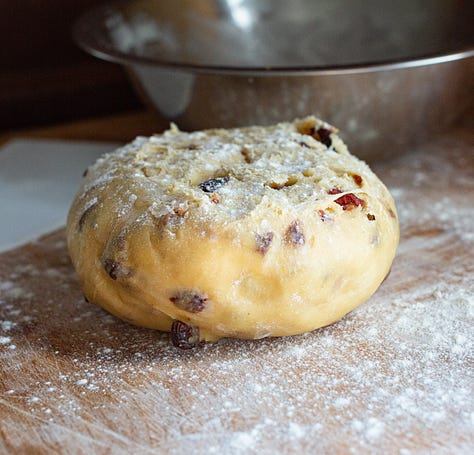
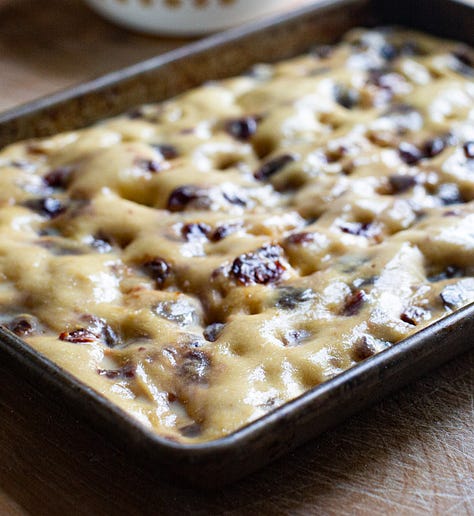
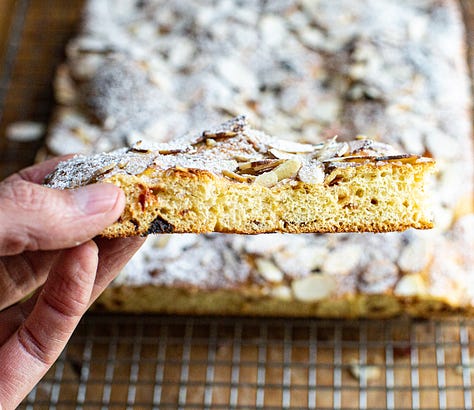
I’m not saying it was a slam dunk out of the oven but it did look great. A pillowy yellow dough dotted with dried bing cherries with deep color at the edges. Every bite brought a sugary crunch and the punch of tart cherries. It was good. But what I remembered from the missed connection was better. Back to the drawing board.
I added more cherries (it was too bready, not decadent enough), more almond extract (not perfumed enough), and changed the dough weight (it was way too thick). Also, the dried cherries pulled moisture and slowed yeast activity, so I needed to fix the rate of rise.
That’s where the iterations began and continued until I thought I was getting close.
But even though I felt like the end was in sight, my doubts persisted. I grilled my family: Is this stuff sweet enough? Does it even need to be sweet? Do I need chunks of almond paste or pastry cream under the almond and coarse sugar? Is there enough lemon (I started adding zest for more aroma)? Is it too thick, too thin, too dry, too heavy, and on, and on.
And then, late one evening in the middle of a test (literally, mid-mix), my KitchenAid mixer broke. I disassembled it down to the worm gear with dough still in the bowl. My daughter Anthem walked through the kitchen. “Oh boy…” she said without breaking stride. A perfect summation.
But, sometimes when things break it causes a shift. The KitchenAid failure led to a whole new tangent (four mixes that night), trying to make plain brioche in a food processor. (Freeze the flour, chill the eggs, and so forth.)
While there were problems with the food processor method (the dough overheats, as expected), it did lead me to try simplifying (I had all those batches to play with, after all). What if I go back to topping the dough (à la Balthazar) rather than putting the inclusions inside? After the umpteenth trip to the store for more dried cherries, eggs and butter, I decided to try one with some fresh cherries I had in the freezer and compare it with the dried fruit version.
The fresh cherry version was the best yet. The dough weight still needed work (without the cherries in the dough the volume and rise was better but now the resulting dough was too thick for my taste). But the important evolution was that the fresh fruit added moisture, producing a more unctuous and moist eating experience (in line with what I’d expect from anything involving brioche). What had been slightly dry before was greatly improved. Getting closer.
At that point I began to feel confident. I took process shots, and patted myself on the back. “Oh, I’ve got this!” In fact, I thought it was good enough that I could trot it around the block. My KABC colleague of behind-the-scenes YouTube fame (he shoots and edits our videos) Tucker Adams moved into a house in the neighborhood. I dropped by with a bag for him to snack on. I handed him a piece, and waited for the thumbs-up.
Tucker and I have worked together enough that I know what his “wow” face looks like. He took a bite, and then another … and offered some tepid approval.
I won’t say I went home dejected but I will admit that his lack of enthusiasm was exactly what I had been thinking myself. It’s good, not great. I went for a walk then came back and considered my options, mixed another dough, and went to bed grumpy. The dough rose and fermented overnight. I tried to dream my way out of the rut.
New day. I got up early and started again. Full sun, birds chirping, optimism is high.
With a half dozen skinned lemons on hand from all the iterations that called for zest I pulled my large bag from the refrigerator and juiced a few, then made a batch of lemon curd. After shaping the dough I set it to rise.
After about two hours I preheated the oven then spread a thin layer of the cooled lemon curd over it and added fresh bing cherries, almond slices, and a little coarse sugar.
I baked it at a relatively high temperature, trying to achieve a full bake with beautiful toppings in a relatively short time, leaving the moisture intact for maximum tenderness and contrast.
I could spend another 1,000 words here describing the tart-on-tart intersection and crunchy almonds and decadent, toothy-but-yielding crust, or the satisfaction that comes from biting something you love but haven’t seen for years. I could talk about how the home we know and dream of is not where it used to be and that even memory is an unreliable measuring stick for how things were or what actually happened. And I could honor the ways that what we make and desire changes with time and how the things we craft reflect who we are and how we breathe at this very moment … but I don’t like to talk with my mouth full. So, I’ll stop here and simply say, make this. Lay down your own connections, enjoy the bake.
Bro-caccia
Yield: Two ¼ sheet trays of focaccia (or 1 focaccia and 6 hamburger buns)
Yeast, dry instant, 12g
Water*, 39g
Eggs, large*, 200g
Honey, 58g
*In cool months use room temperature water and eggs, in warmer months, cold water and chilled eggs will keep the dough from overheating.
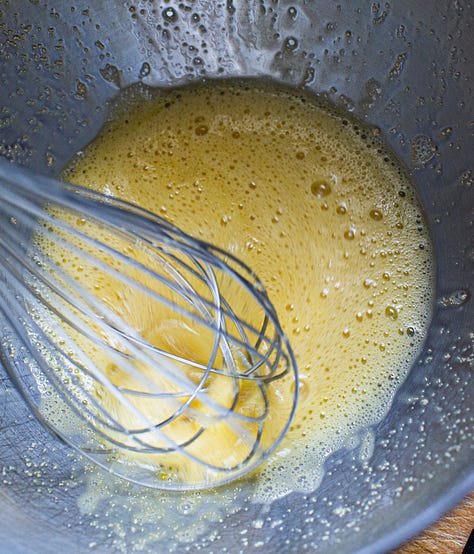
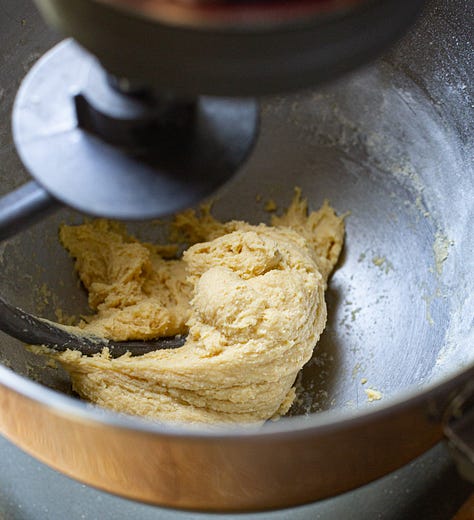
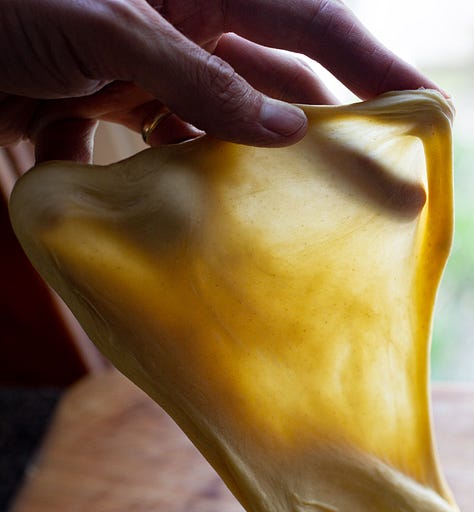
To the bowl of a stand mixer add the yeast, water, eggs, and honey. Whisk vigorously with a hand whisk until well-combined (1 minute or so). *As with the brioche suprêmes of a few weeks ago, this step is to ensure that the yeast is hydrated.
Bread flour (12.7% protein), 387g
Salt, fine, 10g
Add the flour and salt to the bowl then mix with a dough hook for 3 to 5 minutes on medium (speed 4 in a 6 qt. KitchenAid mixer). Scrape down the sides and hook as necessary.
After the initial mix, cover and rest the dough for 5 to 10 minutes.
Butter, unsalted*, 194g
*Butter should be set but pliable. In cool months at my house, room temperature will work. In warmer months (low 70s Fahrenheit and higher), remove from the refrigerator and pound briefly with a rolling pin to soften before use.
After the rest add the butter in stages (roughly 14g or 1 T at a time) while the mixer is running. After each addition, wait until the butter is absorbed before continuing. As always, scrape down the sides and hook as necessary.
The butter addition process will take 8 to 10 minutes on medium (again, speed 4 in a 6 qt. KitchenAid mixer). Once all the butter is incorporated, let the dough take a victory lap for 30 seconds or so.
After mixing, take the dough's temperature. If it measures between 65 and 70˚F, cover and leave for 90 minutes at room temperature. If it's between 70 and 75˚F, reduce the time to 60 minutes.
After the rest, perform a bowl fold and place the dough in a greased small cambro or mixing bowl. Cover with a moisture-proof covering and place in the refrigerator for 12 to 36 hours. *During cold fermentation the dough will develop flavor.

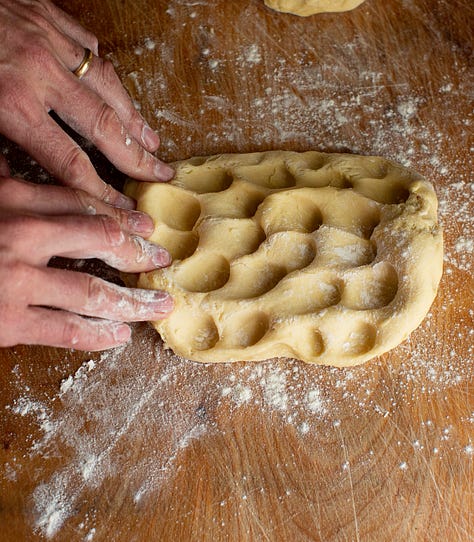
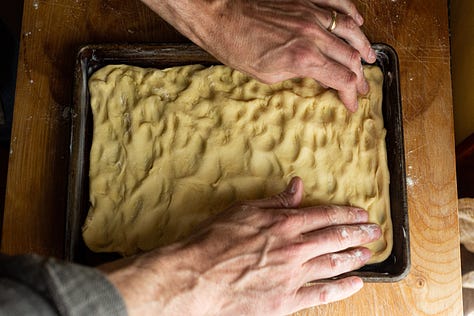
After the cold period remove the dough from the fridge and divide into two pieces, roughly 450g each. (Note that if you’d like only one ¼ sheet of focaccia you may use the second piece for everything from burger buns to brioche Nanterre, Brioche à tête, brioche danish, or even crust for a quiche. Alternatively, you may chill the second piece, making a second focaccia on a subsequent day.)
Gently stretch and dimple the dough into a rectangle roughly 8" by 12" then place into a generously buttered 1/4 sheet tray (butter not only the bottom but also the sides). (Lacking a ¼ sheet tray, you may use a 9” x 13” cake pan. To do so, increase the dough weight to 550g to account for the larger area.)
After placing the dough in the pan, further dimple to evenly distribute the dough, ensuring that the thickness is as even as possible. It will seem thin (⅜” to ½”), but that’s correct.
Set the dough to rise for 2 to 2.5 hours, covered, in a warm spot. (At my house I microwave a mason jar of water for two minutes then place the pan inside the microwave to rise in the warm, moist environment. If it feels humid I don’t bother covering the pan. During the rise I remove the dough and briefly rewarm the jar at least once. It’s a great proofing box.) The dough will inflate and lighten, feeling marshmallowy when it’s ready to bake.
While the dough rises, prepare the lemon curd.
Note that the topping amounts here (the lemon curd, the cherries, almonds, and sugar) are for a single pan of focaccia. If two focaccie are in your future, double those amounts.
Lemon Curd*
3 egg yolks
Lemon zest, ½ lemon
Lemon juice, 56 grams
Sugar, granulated, 78 grams
Add the yolks, zest, juice, and sugar to a small pot. Whisk to combine then heat over medium-low, whisking constantly, until thickened. About 5 minutes.
Butter, unsalted, 56g, cut into pieces
Whisk in the butter. Cover and chill until firm.
*Recipe adapted from Serious Eats
Towards the end of rise preheat the oven to 425˚F convection or 450˚F regular bake.
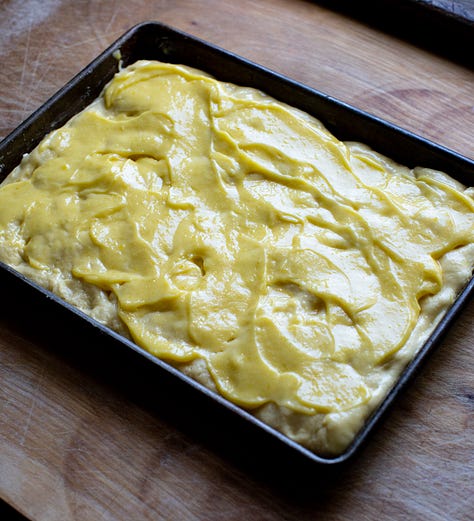
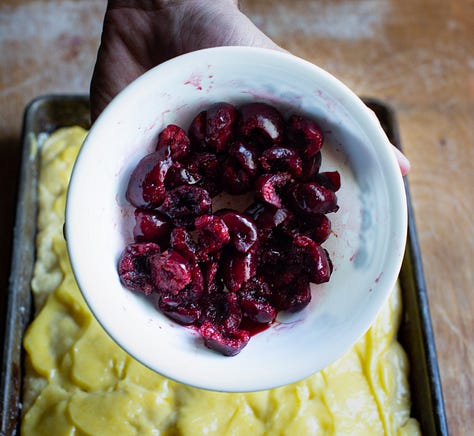
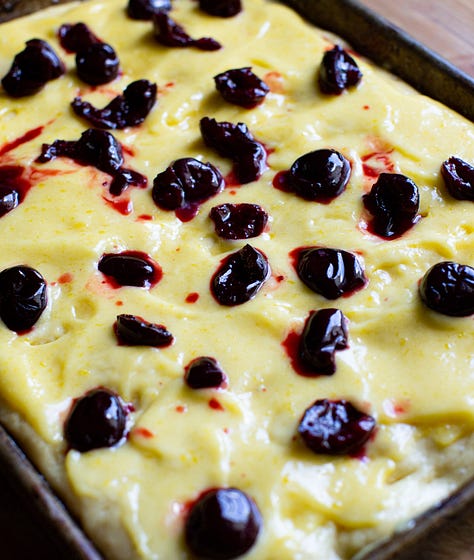
Before the bake gently spread the lemon curd over the surface of the dough, leaving a ¼” border of dough with no topping.
For the topping ingredients I offer a range. We’re into the portion of this process where some personal preference can enter. As with pizza or even sandwiches, fillings and condiments may be to taste. With each amount below, I use the lower range — feel free to find your own range or off-road. This is your Bro-caccia.
Bing cherries*, fresh or frozen, pitted and cut into halves or thirds, 125g to 150g
Almonds, sliced, 75g to 100g
Coarse sugar, (turbinado or sparkling), 20g to 30g
*Note that many other fruits are appropriate swaps: blueberries, ripe plums, peaches, strawberries, and so forth. Frozen works, too. To use, thaw, then drain and proceed.
Add the cherries, distributing evenly across the dough. Then sprinkle the sliced almonds and lastly, the coarse sugar.
Bake the dough for 8 minutes, then check and rotate, if necessary. Bake for another 6 to 8 minutes or until golden brown. For perfect color in my gas oven (with poor top heat) I always broil briefly at the end (1 to 2 minutes). An electric oven with both top and bottom elements may not require this additional step. As always, if you are broiling, set an insurance timer. All your hard work can go up in smoke very quickly. (The extra-toasty almonds are worth the risk.)
The Bro-caccia is done when the crust is golden brown and beautiful and the almonds have colored slightly. Small pools of juice will form where the fruit seeps — yellow rewards of lemon curd will be visible in spots.
Remove the pan and run a thin knife around the edge to release. Then, using a large spatula, gently slide the released focaccia onto a cooling rack to ensure that the crust doesn’t soften during cooling.
Cool for 15 minutes then dust with confectioners sugar if desired. It doesn’t add much sweetness, it’s more about the way that the sugar heightens the visual texture of the toppings. Cut squares and serve while slightly warm. If serving at a later point I like it rewarmed, briefly.

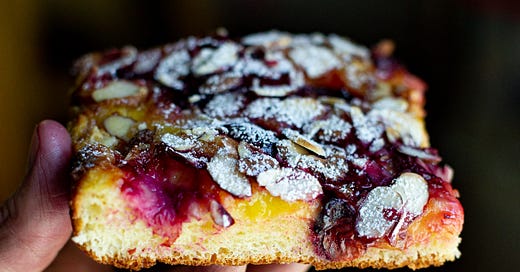


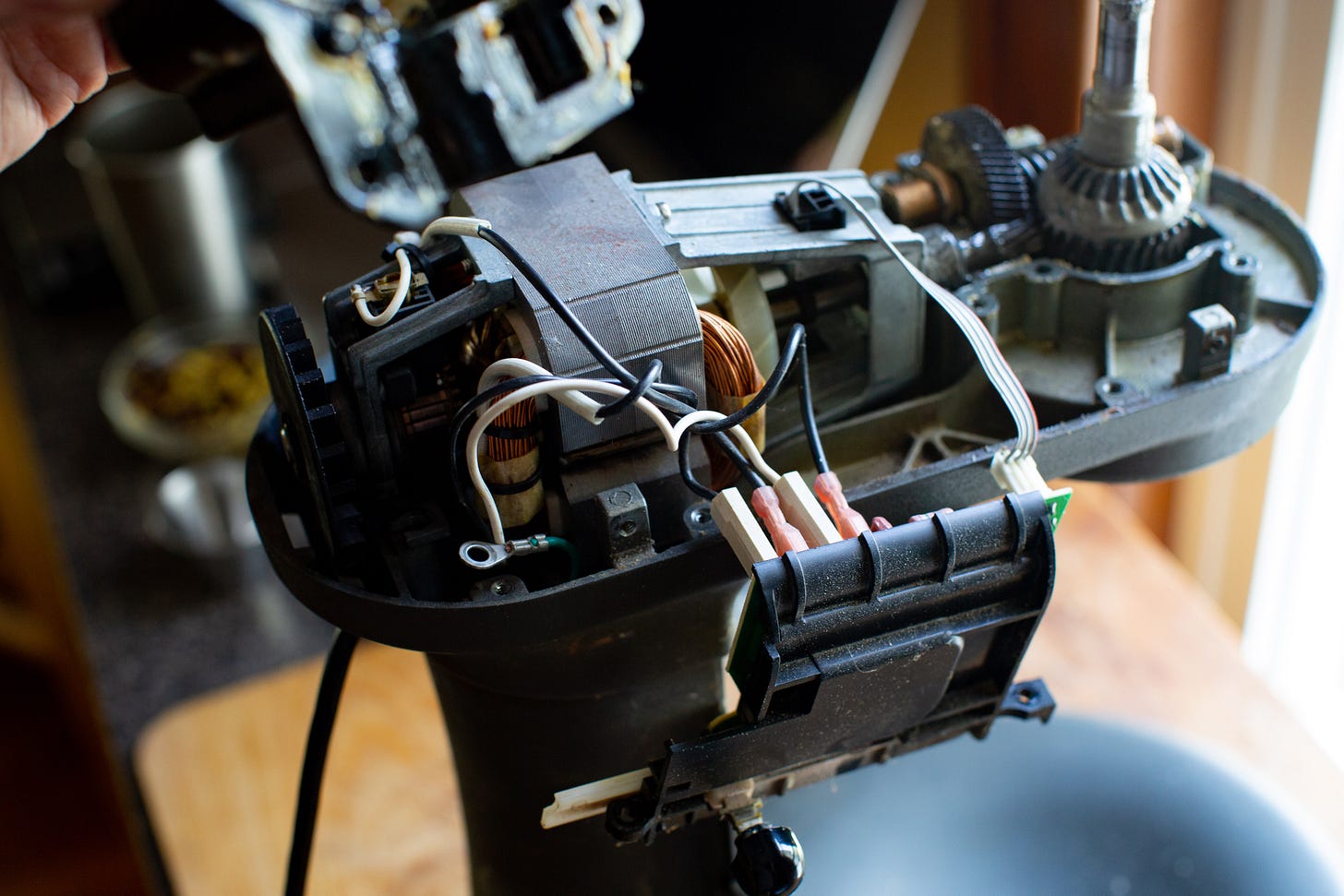

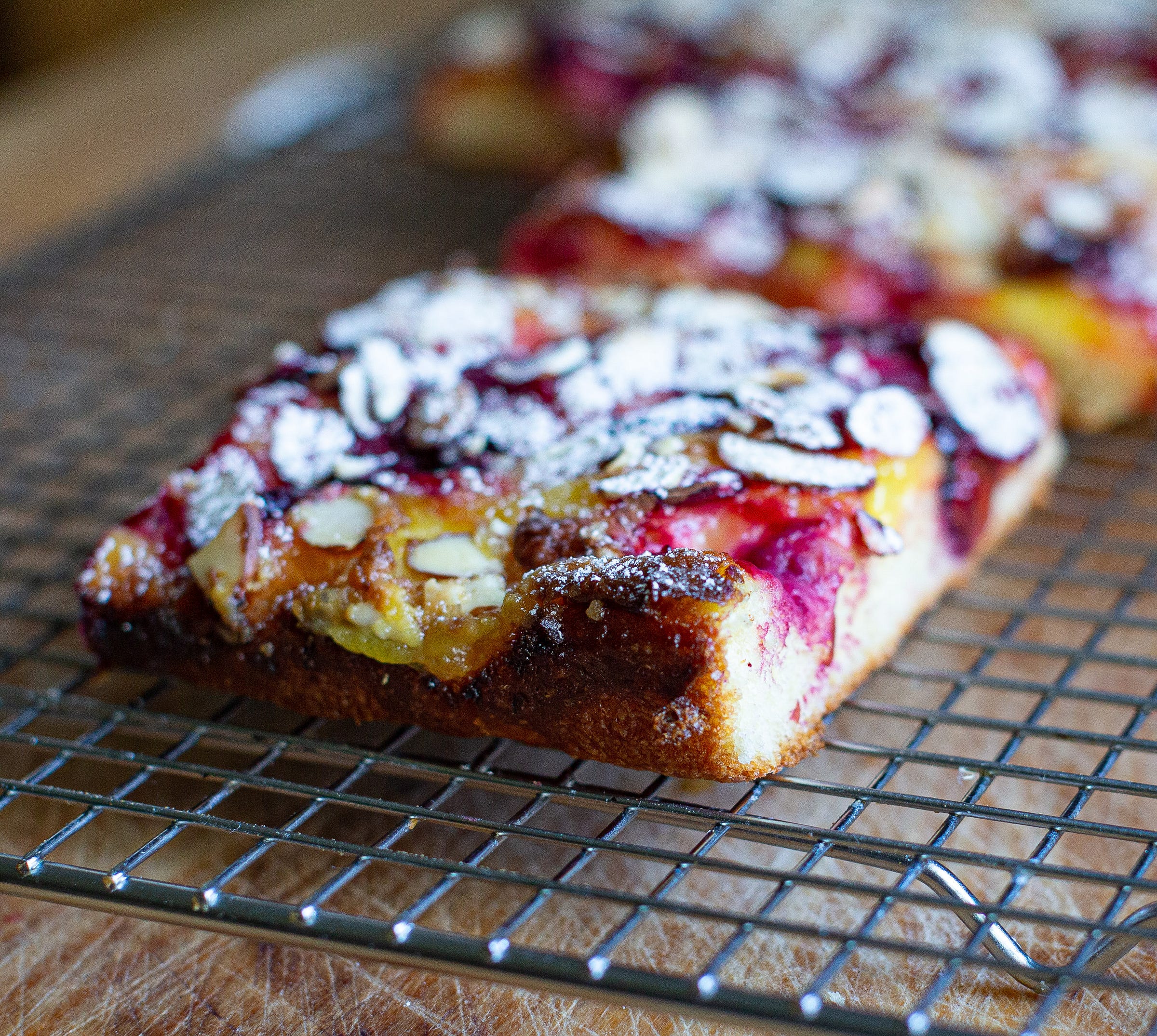
Please write another book!!!!
I just made this for brunch and it was amazing! I loved that the flavors complemented the brioche but didn't overwhelm it, so you still got the deliciousness of the brioche as well. Fantastic recipe!